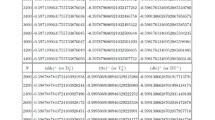Abstract
In this work we show results for light nuclear systems and small clusters of helium atoms using the hyperspherical harmonics basis. We use the basis without previous symmetrization or antisymmetrization of the state. After the diagonalization of the Hamiltonian matrix, the eigenvectors have well defined symmetry under particle permutation and the identification of the physical states is possible. We show results for systems composed up to six particles. As an example of a fermionic system, we consider a nucleon system interacting through the Volkov potential, used many times in the literature. For the case of bosons, we consider helium atoms interacting through a potential model which does not present a strong repulsion at short distances. We have used an attractive gaussian potential to reproduce the values of the dimer binding energy, the atom-atom scattering length, and the effective range obtained with one of the most widely used He–He interaction, the LM2M2 potential. In addition, we include a repulsive hypercentral three-body force to reproduce the trimer binding energy.
Similar content being viewed by others
References
Kievsky A., Marcucci L.E., Rosati S., Viviani M.: High-precision calculation of the triton ground state within the hyperspherical-harmonics method. Few Body Syst. 22, 1 (1997)
Kievsky A., Rosati S., Viviani M., Marcucci L.E., Girlanda L.: A high-precision variational approach to three- and four-nucleon bound and zero-energy scattering states. J. Phys. G 35, 063101 (2008)
Novoselsky A., Katriel J.: Hyperspherical functions with arbitrary permutational symmetry. Phys. Rev. A 49, 833 (1994)
Novoselsky A., Barnea N.: Matrix elements of two-body operators between many-body symmetrized hyperspherical states. Phys. Rev. A 51, 2777 (1995)
Barnea N.: Hyperspherical functions with arbitrary permutational symmetry: reverse construction. Phys. Rev. A 59, 1135 (1999)
Timofeyuk N.: Improved procedure to construct a hyperspherical basis for the N-body problem: application to bosonic systems. Phys. Rev. C 78, 054314 (2008)
Gattobigio M., Kievsky A., Viviani M., Barletta P.: Harmonic hyperspherical basis for identical particles without permutational symmetry. Phys. Rev. A 79, 032513 (2009)
Varga K., Suzuki Y.: Precise solution of few-body problems with the stochastic variational method on a correlated Gaussian basis. Phys. Rev. C 52, 2885 (1995)
Timofeyuk N.K.: Shell model approach to construction of a hyperspherical basis for A identical particles: application to hydrogen and helium isotopes. Phys. Rev. C 65, 064306 (2002)
Viviani M., Kievsky A., Rosati S.: Calculation of the -particle ground state within the hyperspherical harmonic basis. Phys. Rev. C 71, 024006 (2005)
Gattobigio M., Kievsky A., Viviani M.: Nonsymmetrized hyperspherical harmonic basis for an A-body system. Phys. Rev. C 83, 024001 (2011)
Gattobigio M., Kievsky A., Viviani M.: Few-nucleon bound states using the unsymmetrized HH expansion. J. Phys. Conf. Ser. 336, 012006 (2011)
Lewerenz M.: Structure and energetics of small helium clusters: quantum simulations using a recent perturbational pair potential. J. Chem. Phys. 106, 4596 (1997)
Blume D., Greene C.H.: Monte Carlo hyperspherical description of helium cluster excited states. J. Chem. Phys. 112, 8053 (2000)
Hiyama E., Kamimura M.: Variational calculation of ^4He tetramer ground and excited states using a realistic pair potential. Phys. Rev. A 85, 022502 (2012)
von Stecher J., Greene C.: Correlated Gaussian hyperspherical method for few-body systems. Phys. Rev. A 80, 022504 (2009)
Kievsky A., Garrido E., Romero-Redondo C., Barletta P.: The helium trimer with soft-core potentials. Few Body Syst. 51, 259 (2011)
Gattobigio M., Kievsky A., Viviani M.: Spectra of helium clusters with up to six atoms using soft-core potentials. Phys. Rev. A 84, 052503 (2011)
Kil’dyushov, M.S.: Hyperspherical functions of the “Tree” type in the n-body problem. Sov. J. Nucl. Phys. 15, 113 (1972). [Yad. Fiz. 15, 197 (1972)]
Kil’dyushov, M.S.: The n-body problem. Matrix elements of permutations. Sov. J. Nucl. Phys. 16, 117 (1973). [Yad. Fiz. 16, 217 (1972)]
Gattobigio M., Kievsky A., Viviani M.: Nonsymmetrized hyperspherical harmonics approach to A = 6 system. Few Body Syst. 50, 463 (2011)
Nielsen E., Fedorov D.V., Jensen A.S.: The structure of the atomic helium trimers: halos and Efimov states. J. Phys. B 31, 4085 (1998)
von Stecher J., DIncao J.P., Greene C.H.: Signatures of universal four-body phenomena and their relation to the Efimov effect. Nat. Phys. 5, 417 (2009)
Deltuva A.: Efimov physics in bosonic atom-trimer scattering. Phys. Rev. A 82, 040701(R) (2010)
von Stecher J.: Weakly bound cluster states of Efimov character. J. Phys. B At. Mol. Opt. Phys. 43, 101002 (2010)
Gattobigio M., Kievsky A., Viviani M., Barletta P.: Non-symmetrized basis function for identical particles. Few Body Syst 45, 127 (2009)
Hammer H.W., Platter L.: Universal properties of the four-body system with large scattering length. Eur. Phys. J. A 32, 113 (2007)
Author information
Authors and Affiliations
Corresponding author
Additional information
Presented at the Sixth Workshop on the Critical Stability of Quantum Few-Body Systems, Erice, Sicily, October 2011.
Rights and permissions
About this article
Cite this article
Gattobigio, M., Kievsky, A. & Viviani, M. Six-Bodies Calculations Using the Hyperspherical Harmonics Method. Few-Body Syst 54, 657–666 (2013). https://doi.org/10.1007/s00601-012-0460-9
Received:
Accepted:
Published:
Issue Date:
DOI: https://doi.org/10.1007/s00601-012-0460-9



